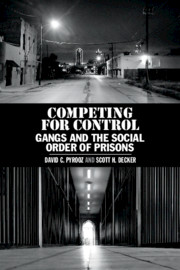Book contents
- Competing for Control
- Competing for Control
- Copyright page
- Contents
- Figures
- Tables
- Acknowledgments
- 1 Foundation for the Study
- 2 Understanding Gangs in Prison
- 3 The LoneStar Project
- 4 The Characteristics of Gang Members in Prison
- 5 The Characteristics of Gangs in Prison
- 6 The Role of Gangs in the Social Order of Prisons
- 7 Misconduct and Victimization in Prison
- 8 Joining and Avoiding Gangs in Prison
- 9 Continuity and Change in Prison Gang Membership
- 10 Implications of Competing for Control
- Appendix Preliminary Evaluation of the Gang Renouncement and Disassociation Program
- References
- Index
6 - The Role of Gangs in the Social Order of Prisons
Published online by Cambridge University Press: 09 August 2019
- Competing for Control
- Competing for Control
- Copyright page
- Contents
- Figures
- Tables
- Acknowledgments
- 1 Foundation for the Study
- 2 Understanding Gangs in Prison
- 3 The LoneStar Project
- 4 The Characteristics of Gang Members in Prison
- 5 The Characteristics of Gangs in Prison
- 6 The Role of Gangs in the Social Order of Prisons
- 7 Misconduct and Victimization in Prison
- 8 Joining and Avoiding Gangs in Prison
- 9 Continuity and Change in Prison Gang Membership
- 10 Implications of Competing for Control
- Appendix Preliminary Evaluation of the Gang Renouncement and Disassociation Program
- References
- Index
Summary
Imagine a prison without formal oversight or regulation. No governance or rules. No correctional officers or authorities. No cameras or monitoring. Such a prison might resemble a Hobbesian state of nature where there is a constant war of atomized individuals engaged in hedonistic pursuits of control and power. Such a state would be intolerable, or, as Hobbes described it: solitary, poor, nasty, brutish, and short. Only in the most extreme and infrequent circumstances – the riots in Attica, New Mexico, and South Carolina (Thompson 2017; Useem 1985) – are US prisons described in these terms. The specter of living in such a Hobbesian state leads people to either cede certain privileges or cooperate with each other in ways that reduce the worst of such disorder. This is another way of saying that order is ubiquitous in institutions, including prisons. In the abstract, orderly prisons are those where operations and routines are largely predictable and stable (Useem and Piehl 2008).
- Type
- Chapter
- Information
- Competing for ControlGangs and the Social Order of Prisons, pp. 122 - 153Publisher: Cambridge University PressPrint publication year: 2019

